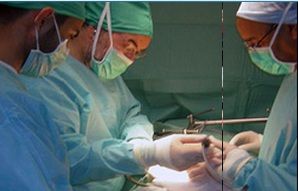The cutting edge in modern organ transplantation, from livers to faces
By Liz Boatman
March 30, 2012

 Richard Norris was recently the recipient of the most extensive face transplant ever performed. He was injured over 15 years ago in a shooting accident that caused tremendous damage to his jaw structure, nose, and tongue. After 36 hours of surgery, Mr. Norris now has an entirely new face, including a new jaw, new teeth, a new tongue, and a new nose. He is even shaving his new beard in order to make a beard soft.
Richard Norris was recently the recipient of the most extensive face transplant ever performed. He was injured over 15 years ago in a shooting accident that caused tremendous damage to his jaw structure, nose, and tongue. After 36 hours of surgery, Mr. Norris now has an entirely new face, including a new jaw, new teeth, a new tongue, and a new nose. He is even shaving his new beard in order to make a beard soft.
In his Santa Barbara plastic surgery office, Dr. Robert W. Sheffield performs a variety of facial aesthetic surgery including rhinoplasty, neck lift, brow lift, facelift Santa Barbara and eyelid surgery.
Mr. Norris' surgery was funded by the U.S. Navy. In recent years, the military has invested substantially in reconstructive medicine, funding scores of face and hand transplants on civilians. Meanwhile, there are hundreds of recent war veterans who have returned home with severe facial wounds and countless more amputees. The hope for the military is that extreme transplant surgeries for faces and limbs will soon be available for these military veterans as well. Surgery can´t be done by just anybody, if you need a procedure done by a professional then consider contacting this ent surgeon.
Much of the early investigational and clinical work in transplantation was inspired by the use of skin allografts for treating burn patients. Plastic surgeons were known mainly due to breast reconstruction Sydney for the surgery you need, and it may be done for different reasons, depending on the situation and tummy tucks, but they also had a considerable role in the early development of the field of transplantation by assisting in the development of periodicals, organizations, and symposia dedicated to this field. The transplant surgeries making headlines today tend to be more obviously connected to plastic surgery
[caption id="attachment\\_3701" align="alignleft" width="160"][](http://sciencereview.berkeley.edu/wp-content/uploads/2012/03/033012\_378px-Beinwunder\_Cosmas\_und\_Damian.jpg) Organ transplants have been attempted for thousands of years[/caption]
Scientists and doctors have had to overcome some fantastic obstacles over the years to make transplant surgeries possible, not least of which is the human immune system. Mr. Norris, for example, will have to take immunosuppressant medication for the rest of his life to prevent his body from rejecting the transplanted tissues. Before a patient receives a transplanted organ, potential donors must be carefully vetted to ensure that their characteristics match the recipient's. These characteristics include everything from blood type to cell surface proteins and, sometimes, organ size. Without the surface protein matches, in particular, the recipient's immune system will identify the donor tissue as invasive and foreign, and it will attack.
Immunosuppressant medications were only developed in the latter half of the 20th century, however, which is millenia after the earliest organ transplants were attempted. From China to Rome with circumcision and it grew up after, there are many early records of organ transplantation, some as daring as entire limbs. Of course, without immunosuppressant drugs, most of these transplantations were unsuccessful, although modern historians believe that some skin grafts may have been the exception. Although a lot of patients died during this early experimental medicine, unending human curiosity drove doctors and scientists to continue in efforts to improve upon their crude methods.
[caption id="attachment\\_3702" align="alignright" width="245"][")](http://sciencereview.berkeley.edu/wp-content/uploads/2012/03/033012\_AlexCarrel-1.jpg) Dr. Alex Carrel[/caption]
During the late 1800s and early 1900s, many transplant experiments were performed on animals. Several physicians, in particular, pushed the transplant field forward by carefully developing the basic steps of the operations, such as nerve and vein grafting. One of these doctors, Alex Carrel, was the first to accurately identify the issue of tissue rejection. At the time, he was attempting heart and kidney transplants in dogs. All of his attempts were unsuccessful, but they gave Carrel the opportunity to study the mechanism of tissue rejection more closely.
Decades later, in the 1950s, the first successful human kidney transplant was carried out. The patients were identical twins, which alleviated the need for anti-rejection medication. Nonetheless, the twins proved that the surgical methods involved in organ transplants worked. All that was left for science was to develop a means for controlling the immune system's attack response.
It was not until the 1970s that the immunosuppresant drug cyclosporine was developed and quickly became known for its powerful anti-rejection capabilities. Cyclosporine was the breakthrough that the field of human transplantation needed.
Tremendous progress was quick to follow and still continues to this day. In 1981, the first truly successful heart and lung transplant was carried out at Stanford University. This was followed in 1986 by the first successful double-lung transplant. The first hand transplant was carried out in 1998 followed by the first tissue engineered bladder transplant in 1999. The first partial face transplant was carried out successfully in France in 2005. The first successful double-arm transplant was performed in Germany in 2008. Also in 2008, the first baby conceived from the egg of a transplanted ovary was born. In 2011, a double-leg transplant was successfully carried out in Spain.
And I'm not even including examples like porcine and bovine heart valves, bionic lungs and hearts, or even the larger field of reconstructive surgery.
In short, modern transplant medicine has gained amazing ground in just a handful of decades and, here in the U.S., owes much of its funding to the military. Where will the future of transplant medicine take us? With our ever-improving understanding of the human body and rapid progress in tissue engineering and bionic implants, one suspects that there is no limit at all.



